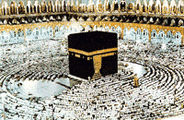|


New Page 1
A video revealing Atkins’ plans
for the redevelopment of the Masjid al-Haram, the holiest site in Islam,
has been leaked on the internet
A number of British architects,
including
Norman Foster and Zaha Hadid
have been approached to draw up plans to increase the capacity of the mosque
in Mecca, Saudi Arabia.
The efforts to regenerate Mecca come
as the government struggles to accommodate ever increasing numbers of
religious tourists who visit on the Hajj and Umra each year. Official
figures state some four million pilgrims visited Mecca in 2007 to perform
the Hajj.
The government is looking to
increase the number of international visas issued to pilgrims, which will
place even greater pressure on the city.
|
New Page 8
|
Mecca expansion plan, led by Western architects ~
causes controversy |
| A report that two London architects have been enlisted
to lead a massive redevelopment of Mecca, Islam's holiest site, has sparked fierce debate in architectural circles.
In late November, U.K. publication The Architects' Journal broke the news that two internationally
renowned architects — British star Norman Foster and Iraqi-born Zaha Hadid — have been quietly enlisted by Saudi
Arabia's King Abdullah for lead roles in the expansion project.
"We were absolutely stunned," the magazine's editor, Kieran Long, told CBC Radio's Q
in an interview from London on Wednesday.
'This is Mecca and it has to be done in a very special way'— Sami
Angawi, architect
"We know that both these architects have a lot of work across the Middle East and Western
architects are very respected there," he said.
"But we didn't expect a city like Mecca to invite architects like these to come in,
not least because they won't be able to visit the site. One of the distinguishing features of Mecca is that non-Muslims are
not allowed in. It's clearly very tricky to build a building in a place you can't actually visit."
Heading any scheme without being able to personally visit the site itself would be complicated enough,
never mind a project of this magnitude, Long said.
According to the magazine, the plan encompasses a 10-year, phased expansion that includes enlarging
the central Haram mosque to accommodate first 1.5 million people (from its current official capacity of about 900,000) and,
eventually, all three million visiting pilgrims.
Criticism of the expansion arises
News about the project quickly spread in the design world. Still, the issue remains sensitive, with
some Islamic figures already critical of the decision, Long said.
"What we've seen with these 'starchitects,' these kinds of makers of iconic buildings,
is that they've been brought into places which perhaps don't have a cultural identity," Long pointed out, citing the current
rapid cultural building boom in the United Arab Emirates or how Canadian Frank Gehry's Guggenheim Museum Bilbao was intended
as a boost to the Spanish city.
Mecca is not quite in that same situation, he said.
"If you believe, as I and many others do, that architecture is partly derived from ritual and from
the conduct of people in the city, you can't have a one-sized fits all solution. You can't just dump a shape there and hope
that people make good."
Acknowledging that non-Muslim architects could perhaps "do miracles, something that we have not seen
before" at Mecca, "you cannot do a place, however small, without being in the site," agreed Sami Angawi, director of Jeddah,
Saudi Arabia's AMAR Centre for Architectural Heritage.
Muslims should have been consulted: Angawi
According to Angawi, a key point that has riled critics of the plan is not the hiring of Western architects.
It is that the decision-makers went to outsiders first, rather than turn to Muslims practitioners who
have knowledge of Islamic history, an understanding of and reverence toward the site's significance and who have also experienced
the Hajj (the annual pilgrimage to Mecca) made by between two million and three million worshippers each year.
"Yes, [non-Muslim architects and engineers] can participate and one would be honoured to work with
such people in any project, but it's not that you start there ... It has to start with us," said Angawi, who earned his post-graduate
degrees in the U.S. and London.
"This is not Dubai, this is not Abu Dhabi. This is not anywhere else. This is Mecca and it has to be
done in a very special way: knowing the history of the place, feeling it, being involved in it, drinking it, having it inside
you. And then reflecting it [in a design]." | | |
New Page 9
Present Expansion Plans In Progress
|